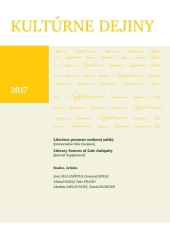Svatý Jeroným jako pramen v cestopisu Kryštofa Haranta z Polžic a Bezdružic
Saint Jerome as a Source in the Travel Book by Christopher Harant of Polžice and Bezdružice
Author(s): Markéta MelounováSubject(s): History
Published by: VERBUM - vydavateľstvo Katolíckej univerzity v Ružomberku
Keywords: Saint Jerome;Christopher Harant of Polžice and Bezdružice;Czech Renaissance travel book
Summary/Abstract: The paper focuses on the personality and writings of Saint Jerome as they appear in the travel book by the Czech Renaissance nobleman Christopher Harant of Polžice and Bezdružice (1564–1621). The book was first published in 1608, bearing an elaborate title “The Pilgrimage or Journey from the Kingdom of Bohemia to the City of Venice, from there by Sea to the Holy Land, the Land of Judah and further to Egypt and the Great City of Cairo, then to the Mount Oreb, Sinai and the Mount of Saint Catherine, Virgin, that Lies in the Arabia Deserta etc.” The work quotes a great number of sources ranging from classical antiquity to Harant´s contemporaries, while Harant often amazes readers with his vast knowledge of authorities, quoting not only authors and titles but often also books and chapters. The paper analyses the occurrences of the Latin Church Father Sophronius Eusebius Hieronymus in the travel book, as well as Harant´s perception of him and the ways in which he applied Jerome´s writings.The Jerome of the travel book of Christopher Harant is a learned man, an authority worth quoting, as well as a representative of ascetic life. Even though his work is not quoted as often and in such a detail as e. g. those of Flavius Iosephus or Pliny the Elder, he occupies an honourable position in the area of biblical topography comparable to that of the Bible and Iosephus. Harant gives much importance to his eyewitness testimony; Jerome visited Holy places and was living, writing, and translating in Palestine for a long time. Furthermore, Harant stresses Jerome´s eremitic experience and depicts him as an ideal of a strict Christian life for his devoted readers. In addition, Jerome functions as a role model to Harant himself during his travels through the Holy Land. He regards Jerome´s notes on holy places worth quoting, as he obviously lived at a time closer to biblical era and was a contemporary or almost a contemporary of some of the saint men and women in the Eastern deserts. Considering the form and quality of quotations, we can assume with a high degree of certainty that Harant really worked with Jerome´s writings he refers to. Jerome as a source and as a historical figure mostly appears in the first part of the travel book dedicated to the journey to the Holy Land; however, in the second part, which describes the journey to Egypt and Sinai, he occurs less frequently. Harant used various works of Jerome (letters, especially No. 108 to Eustochium, biblical commentaries, De viris illustribus, polemics) or works falsely ascribed to Jerome (biblical commentaries, Vitae Patrum) from which, though they do not primarily deal with topography, Harant did not hesitate to quote even slight topographical remarks like, for example, the name of the place. As Jerome was one of Harant's main authorities for biblical topography, he most frequently cites Jerome´s revised translation of Eusebius´s topographical lexicon De situ et nominibus locorum Hebraicorum (sometimes along with or mismatched with the pseudo-Jerome´s Liber nominum locorum ex Actis apostolorum).Jerome as a source and a historical figure meets both requirements that Harant imposed on his travel account: he can convey both scientific and moral instruction to the readers.
Journal: Kultúrne dejiny
- Issue Year: 8/2017
- Issue No: Supplem
- Page Range: 63-76
- Page Count: 14
- Language: Czech

